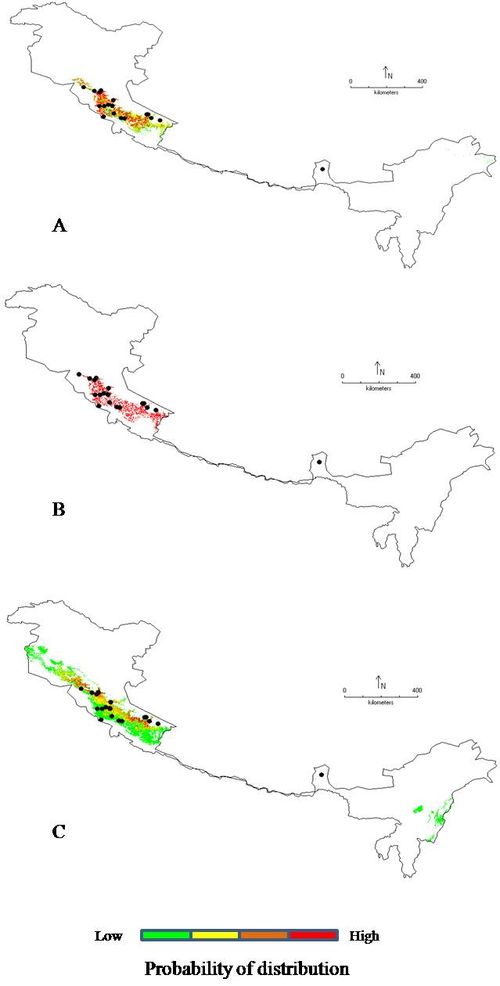|
Result and Discussion
Predictions of the potential distribution of Berberis aristata in Indo-Himalayan region are comparable based on its current distribution in the region. Model outputs are varied according to the modeling techniques (Figure 2 A, B and C).

Fig 2. Modelling outputs from three different algorithms (A = GARP, B = Bioclim, C = MaxEnt)
Both the GARP and MaxEnt models show distribution spread in western and eastern Himalayan states of India. On the contrary, Bioclim output is restricted in western Himalayan region i.e., Himachal Pradesh and Uttarakhand. All three models show higher accuracy and AUC value near 1.0 with low omission error (Table 2).
Table 2. Comparative details of the modeling outputs
| Parameters |
Modelling techniques |
| GARP |
Bioclim |
Maxent |
| Accuracy |
86.66 |
100 |
- |
| AUC value |
1.0 |
1.0 |
0.969 (training set)
0.947 (test set) |
| Omission error |
0.142 |
0 |
- |
| Total distribution (% of total area) |
4.63 |
2.44 |
10.36 |
| High probability area (% of total distribution) |
29.65 |
100 |
6.27 |
Modelling outputs reveal that, MaxEnt has predicted largest area (10.36% of Indo-Himalayan region) under potential distribution in comparison to GARP (4.63%) and Bioclim (2.44%). However, Bioclim has higher high probability regions (100%) than GARP and MaxEnt (i.e. 29.65% and 6.27% respectively). Both GARP and MaxEnt have shown a wider range of distribution from low to high probability in Himachal Pradesh, Uttarakhand, Jammu-Kashmir, Arunachal Pradesh, Nagaland and Manipur whereas, Bioclim distribution is restricted as high probability areas in Himachal Pradesh and Uttarakhand.
The jackknife test of variable importance in MaxEnt has identified the precipitation of driest quarter (bioclimatic variable 17) as the most important environmental variable in model development. This variable has highest predictive value or gain when used in isolation. Other variables like precipitation of coldest quarter (bioclimatic variable 19), temperature seasonality (bioclimatic variable 4), mean temperature of coldest quarter (bioclimatic variable 11) and minimum temperature of coldest month (bioclimatic variable 6) also have considerable predictive value with regard to distribution of Berberis aristata.
Potential distribution maps show various possibilities for conservation and management of this valuable plant species. Clustering of high probability areas in the North-western states around the occurrence points indicate the suitability of the region for further exploration as well as reintroduction / conservation program as it satisfies fundamental niche requirement of the species. Considering the mountainous inhospitable nature of the Himalayan region, targeting high probability regions for future exploration could increase the probability of success in the venture. Earlier endevours involving field surveys / exploration based on model outputs had helped in discovering new populations as well as allied species (Raxworthy et al., 2003; Siqueira et al., 2009). This prior information on species probable distribution in the area certainly helps in judicious utilization of resources and time. On the other hand, new areas like eastern Himalayan states have come out as potential occurrence sites for the species as evidenced through GARP and MaxEnt outputs. At present we have only one occurrence record from this site (i.e. Sikkim) but further studies may improve the candidature of the region as favorable site for the Berberis aristata. This idea gets support from available literature on Berberis spp. distribution in India, where several other species of Berberis viz,, B. asiatica var asiatica, B. parisepala, B. macrosepala var macrosepala, B. insignis, B. dasyclada etc. have been reported from north eastern Himalayan states (Sharma et al., 1993). The presence of other species in the region may open up the possibilities for B. aristata as several studies have indicated niche conservatism among the closely related species (Peterson, 1999). However, this could only be verified after field exploration and collection of information.
This exercise could be useful for comparing natural resource distribution pattern and conservation / management strategies to protect them. Application of species distribution modeling in conservation area planning and management is widely used nowadays (Araujo and Williams, 2000; Ortega-Huerta and Peterson, 2004; Pearson, 2007). By knowing the potential distribution region, especially the high probability areas (here it is part of Uttarakhand and Himachal Pradesh), it is possible to design conservation priority zone / resource management zone with an emphasis on species ecological boundary. This approach from ecological viewpoint makes species survival and management easier and more efficient than other practices.
|



